By now, you know that content marketing is a highly effective way to grow your B2B or B2C brand. Whether you’re a SaaS company, a tech brand, or a startup, nailing your content marketing is critical to your future success.
Need more proof that content marketing is where it’s at? Yeah, we feel you. We love hard data, and that’s why we’re bringing you the most meaningful, most impactful content marketing statistics. If you’re still unsure you need content marketing, read on because we brought the receipts.
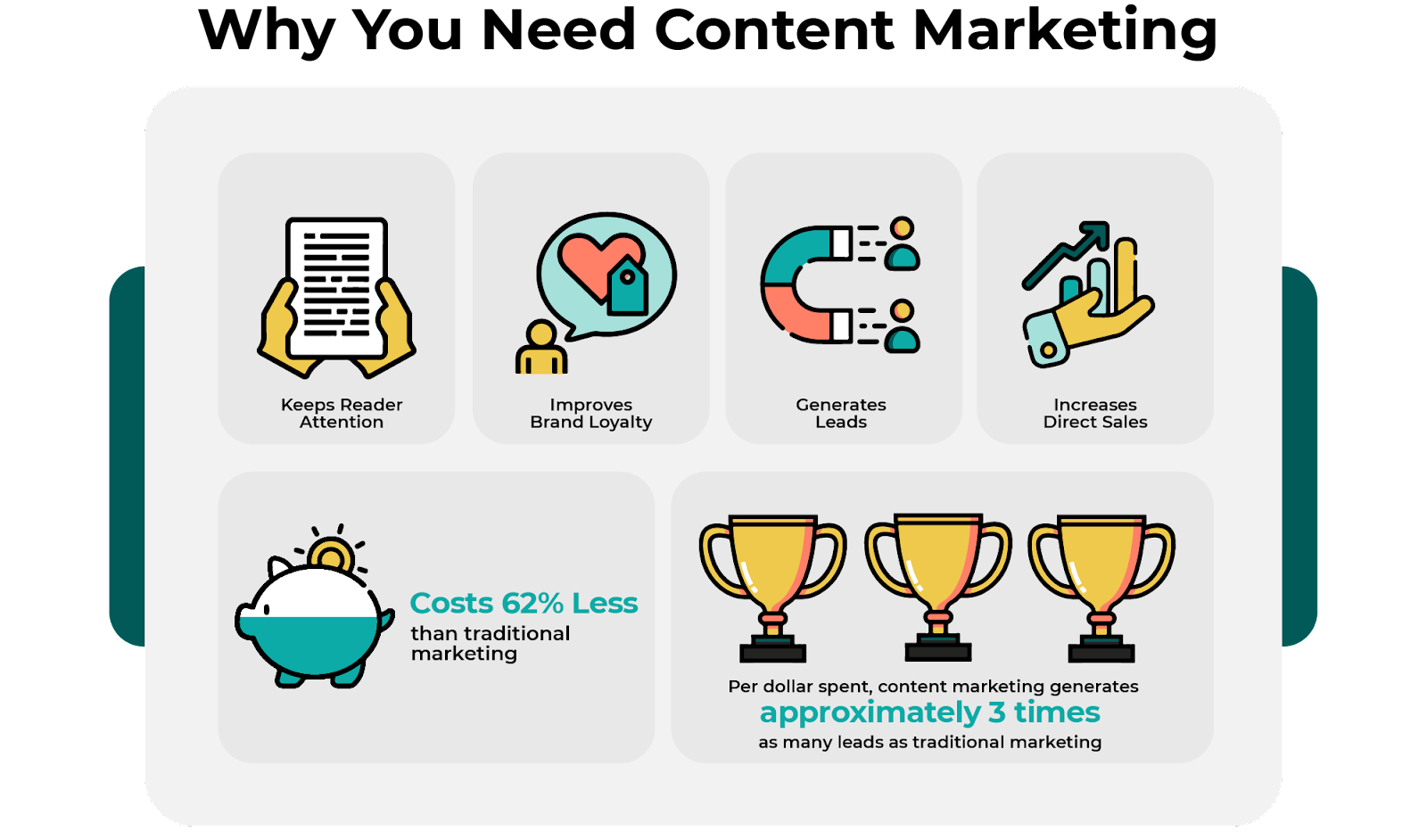
To break it down, content marketing costs less but does more. Want to know how? Let’s dive into the numbers:
Content Teams Statistics
Before you can reap the rewards of content marketing, you need to have the right team of experts. That might be internal team members, or it might be part of an outsourced, third-party agency. As you see below, most brands have 1-3 team members specializing in content marketing, but the next most popular response? Not one dedicated professional on staff.
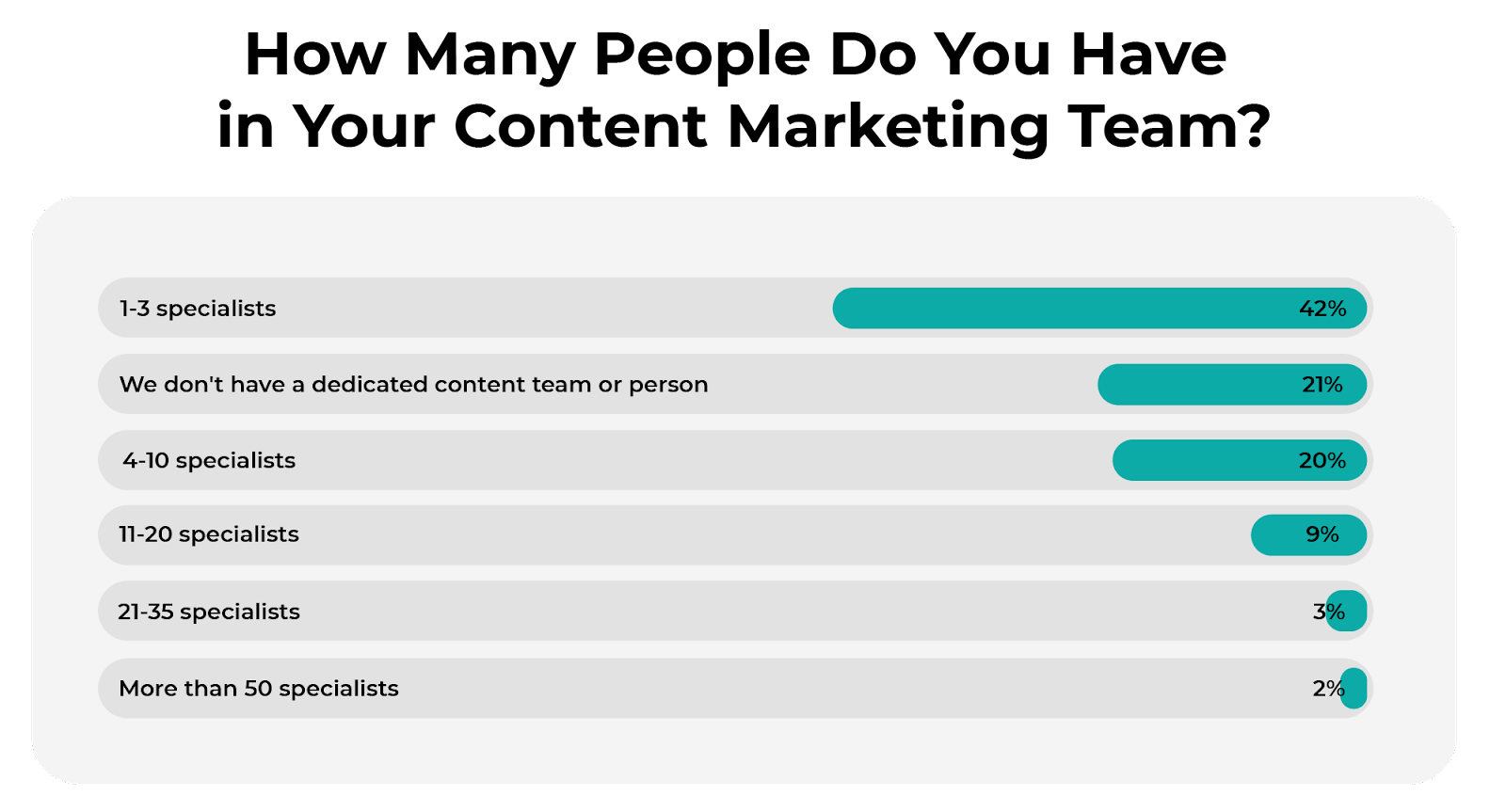
Here are more stats on content marketing teams:
- Only 5% of marketing pros said their content team was structured for future success — the majority (50%) said their team “needs work.” (Knotch)
- 30% of companies outsource content creation, but 70% keep it in-house. (Semrush)
- Among B2B brands, 44% of top performers have a centralized content team that works on brands and initiatives across the organization. (Content Marketing Institute)
- Nearly all marketing pros say their content teams will either grow (48%) or stay the same (49%) — just 2% say they plan to downsize. (Semrush)
- Content marketers love their jobs — 85% say it offers them a meaningful career path. (CMI)
Content Marketing Usage Statistics
How do both individuals and marketers use content marketing? Well, here’s an example: You’re using content marketing right now, and so are we. We’ve created this article (content) to provide you with information we hope is useful. You’re reading this article (content) to gain some knowledge. Hopefully, you’ll get what you need out of our content, and we’ll get what we need from a satisfied user.
The bottom line is this: Content is everywhere. We’re either creating it or interacting with it pretty much every day. But if you’re still questioning why brands like yours use content marketing, here’s the scoop:
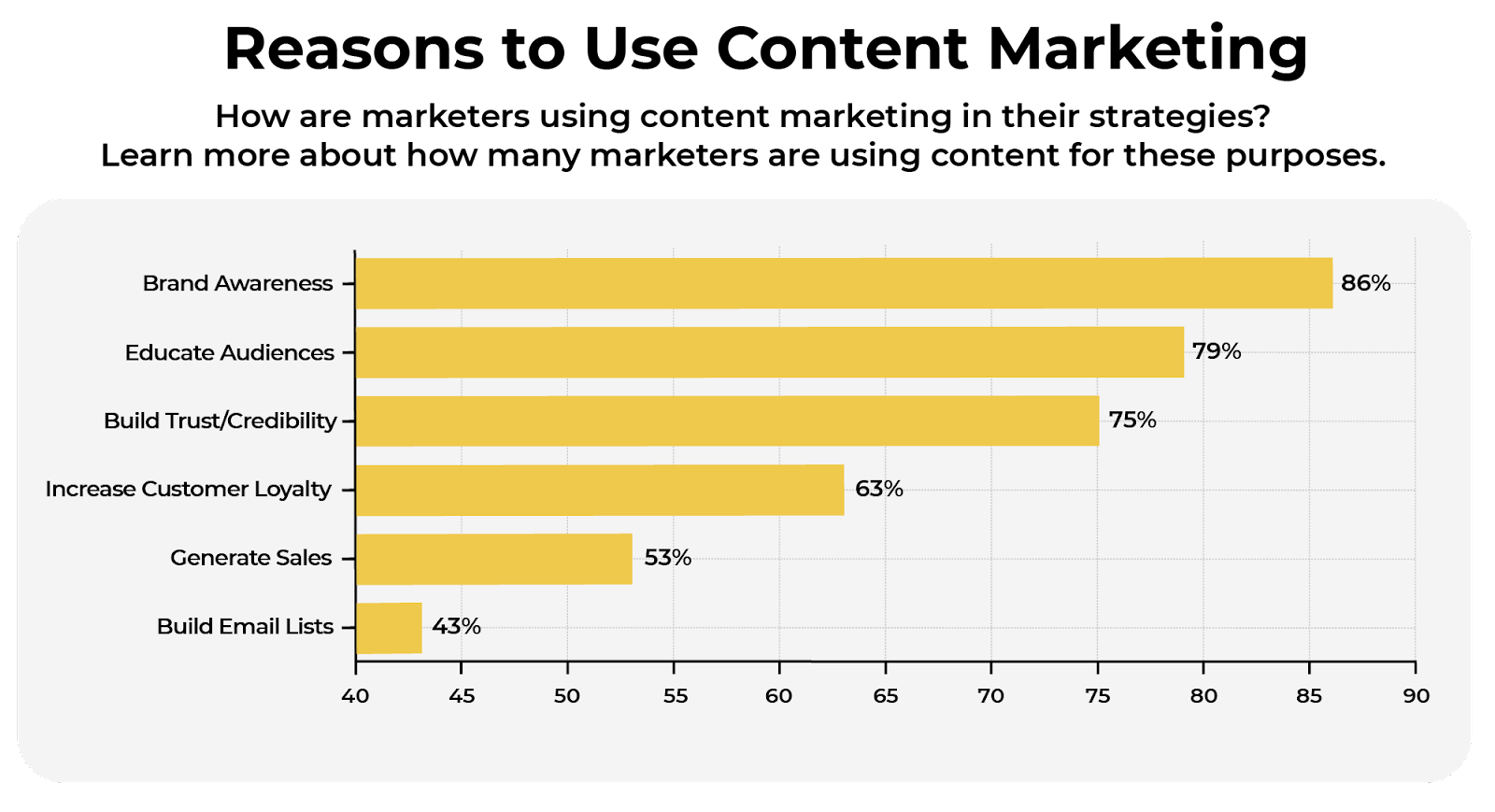
What else do you need to know about how content is used by consumers and brands?
- More than 80% of people are online at least once a day, while more than 30% say they spend most of their time online. (Pew Research)
- 91% of B2B marketers are using content marketing to achieve their goals. (CMI)
- Fewer B2C brands (86%) say they’re using content marketing as a top strategy. (CMI)
- A large percentage (40%) of marketing pros said they do not have a content marketing strategy. (Semrush)
Content Marketing Success
What makes a content marketing strategy a success? Is it sales? Revenue growth? Leads?
It’s likely a combination of factors based on the metrics and KPIs that drive you toward achieving your goals. Content marketing is certainly highly effective, but success looks different for every brand.
One common indicator of success is customer retention, particularly for SaaS and B2B brands that offer free trials and freemiums.
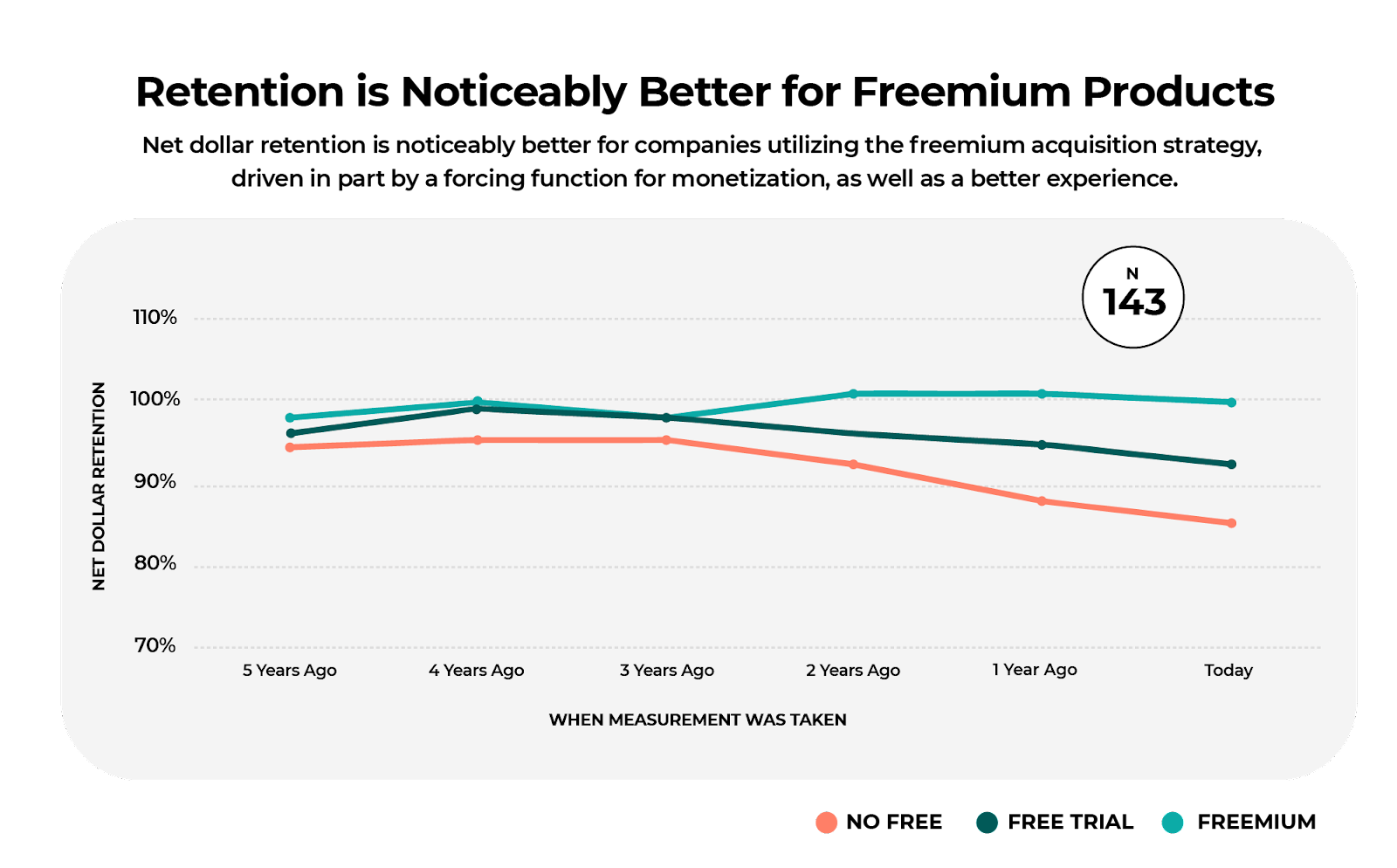
But that’s not all. Here’s what we can learn about content marketing success:
- A majority (55%) of marketers who reported their content marketing strategy was a success focused primarily on improving content quality. (Semrush)
- Among tech marketers, 32% said their content marketing efforts in 2022 were “extremely” or “very” successful, while a majority (53%) said they were “moderately” successful. (CMI)
- B2B marketers are slightly less likely to say their content marketing efforts were extremely or very successful (29%) but more likely to say they were moderately successful (56%). (CMI)
- 65% of marketers do not regularly evaluate the success of their content strategy. (CSR)
- Over 60% of marketers measure content marketing success through sales. (HubSpot)
Goals and Challenges of Content Marketing
Content marketing is extremely effective, but it takes a major investment of time and planning. It also requires more people power than some strategies. The biggest key to success is setting the right goals for your content marketing strategy.
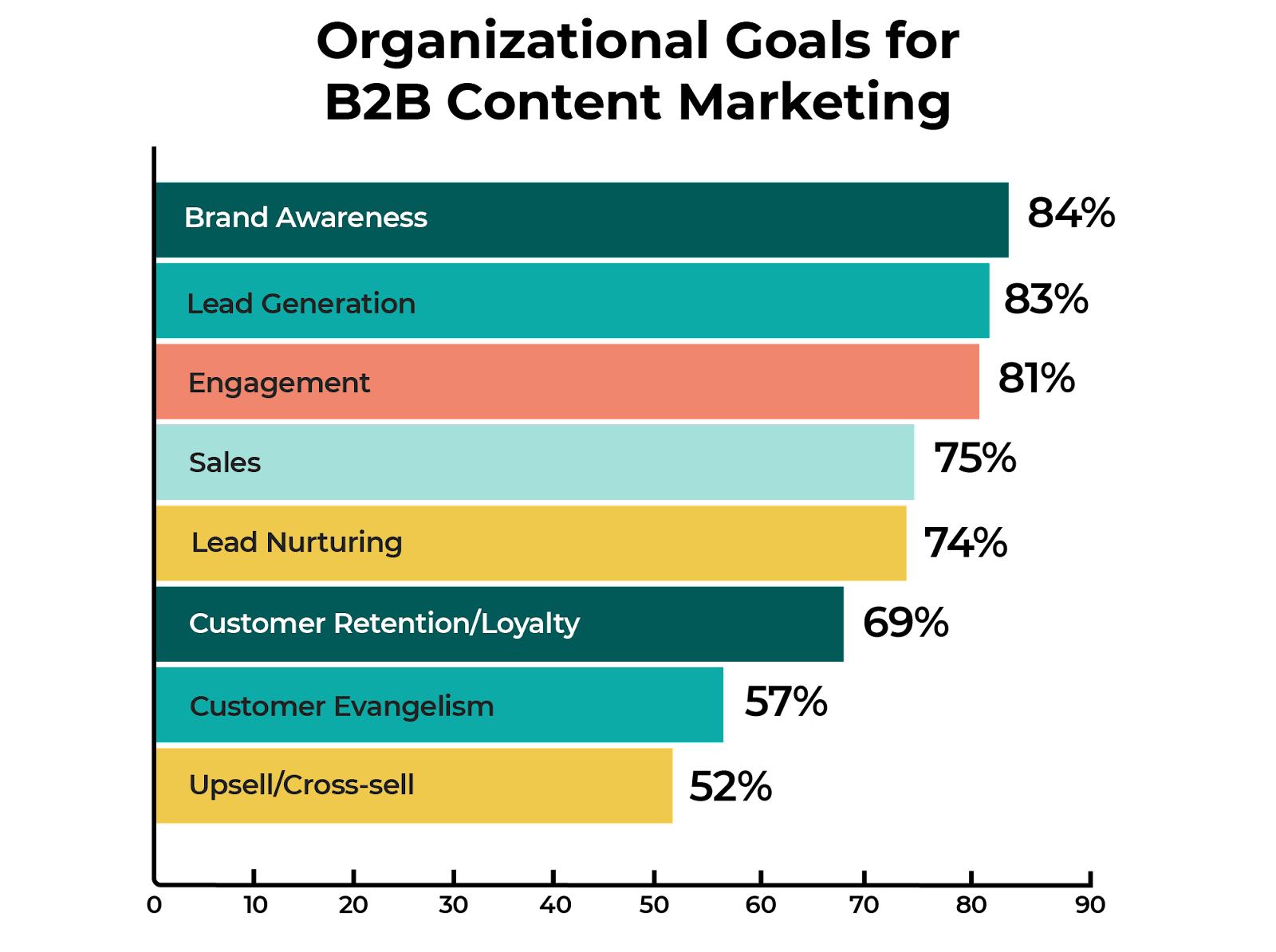
Other goals and challenges of content marketing include the following:
- Using content to attract leads is the biggest challenge (41%) for marketers. (Semrush)
- Among B2C marketers, creating engaging content is the biggest challenge for 56%. (CMI)
- The biggest challenge to creating effective content articles is budget, according to 47% of marketers. (Marketing Charts)
- 58% of marketers say the biggest barrier to strategic content management is communication across teams. (Marketing Charts)
- Among marketers, 70% say their top goal for social media content is to increase brand awareness. (Sprout Social)
B2B Content Marketing Statistics
B2B brands have different considerations and concerns around content marketing than their B2C counterparts. A longer selling cycle, a different audience, and varying efficacy of marketing tactics mean there’s no one-size-fits-all solution.
But there are certainly trends we can identify around B2B content marketing, like the success and popularity of creating case studies:
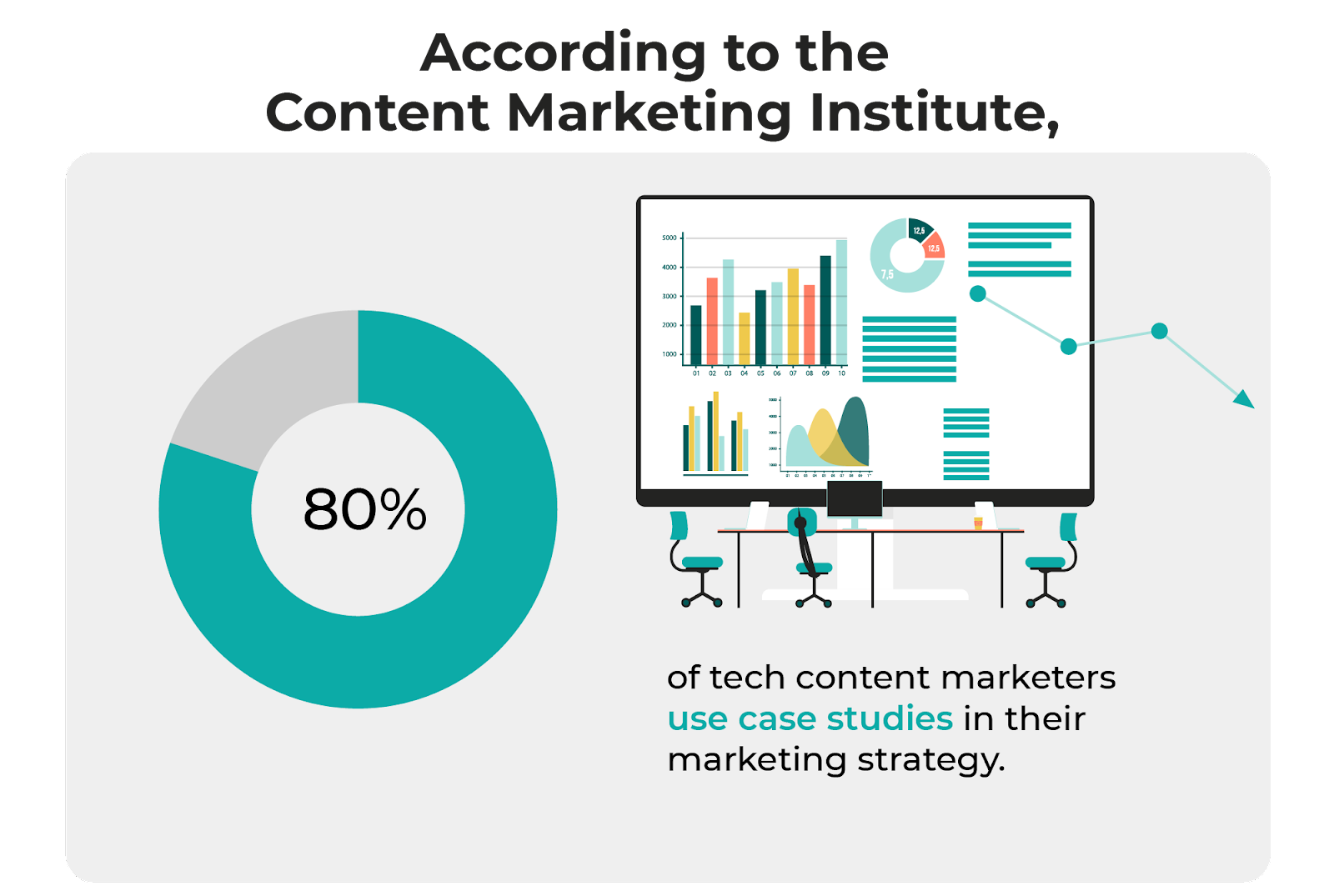
Here are more stats you need to know about B2B content marketing:
- 83% of B2B marketers say they differentiate themselves from the competition by focusing on creating better quality content. (CMI)
- The top three content assets used by B2B brands in the last 12 months include short articles (89%), videos (75%), and case studies (67%). (CMI)
- In-person events are back, with 48% of B2B marketers saying they were the most effective content asset in the last 12 months. (CMI)
- Among B2B buyers, 95% said they view content as a marker of trust when entering the decision stage. (Ziflow)
- 84% of B2B marketers say content creation is what they’re most likely to outsource. (Backlinko)
B2C Content Marketing Statistics
On the flip side, we have B2C content marketing, which is a whole different animal. Although the two might share some of the same goals and employ a few of the same strategies, they are vastly dissimilar.
So, where are B2C marketers investing their time and money?
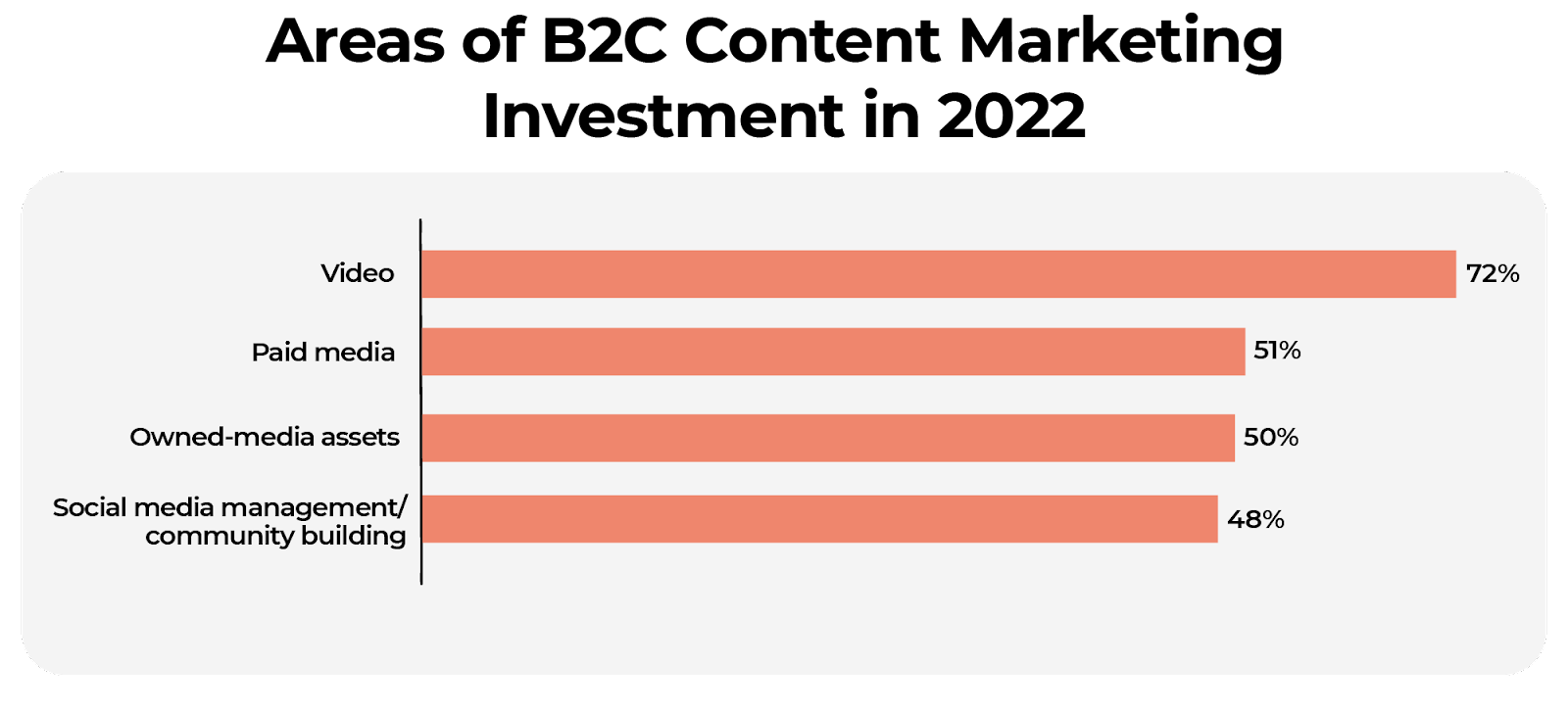
What else should you know about B2C marketing? Here’s the data:
- 65% of B2C marketers say they prioritize the audience's needs over their sales goals. (CMI)
- The top three types of content assets created by B2C marketers in the last year include short articles (83%), videos (61%), and infographics (51%). (CMI)
- Of video content, the most successful types were how-tos (38%) and expert interviews (37%). (CMI)
- Facebook was the top social media platform for B2B brands, at 88% usage. (CMI)
- 62% of B2C marketers plan to use influencer marketing in their content strategy in the coming year. (HubSpot)
- Over 80% of B2C marketers are investing more of their budget into inbound content marketing this year. (HubSpot)
User-Generated Content Statistics
User-generated content (UGC) is becoming more popular each year. UGC is a cost-effective way to harness the power of your greatest asset — existing customers. UGC also comes with many other benefits, like how it influences public perception of your brand.
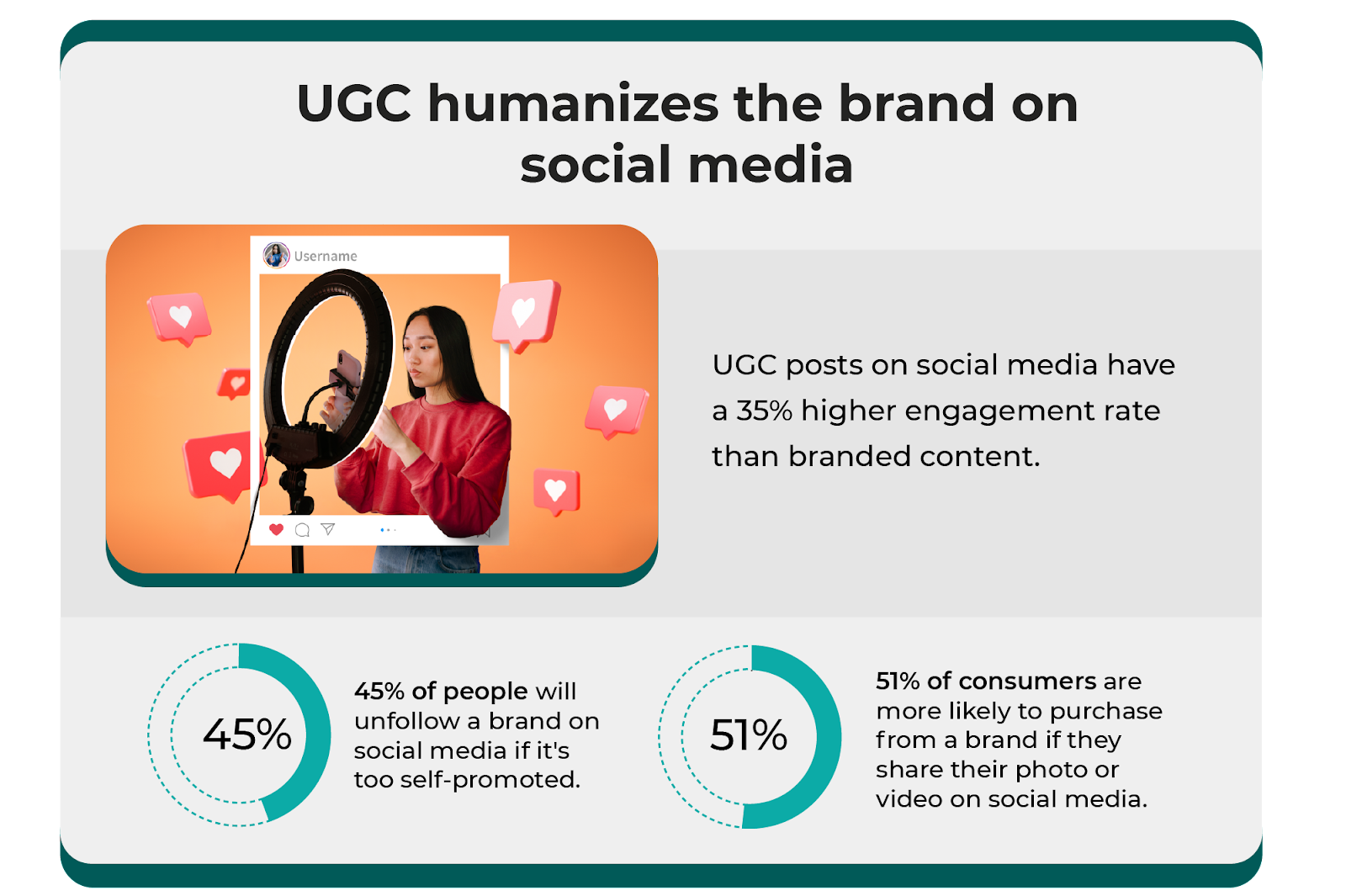
Here’s more of what you should know about user-generated content:
- 79% of consumers say UGC impacts their purchasing decisions. (Oberlo)
- 62% of consumers say they’re more likely to click on content that’s been created by a customer. (Tint)
- 60% of consumers say they wish brands would tell them what kind of content they should create. (Tint)
- When it comes to authenticity, 60% of consumers believe UGC is more genuine than content created by brands. (Taggbox)
- Brands that include UGC on their website notice a 90% increase in the time spent on the site. (HubSpot)
Content Marketing ROI Statistics
Content marketing ROI can be hard to measure. While sales and revenue can and will increase as you deliver quality content, other benefits aren’t as easy to pin down, like brand awareness and audience perception.
One thing we do know is that the best ROI comes with repurposing and redistributing the content you’ve already got.
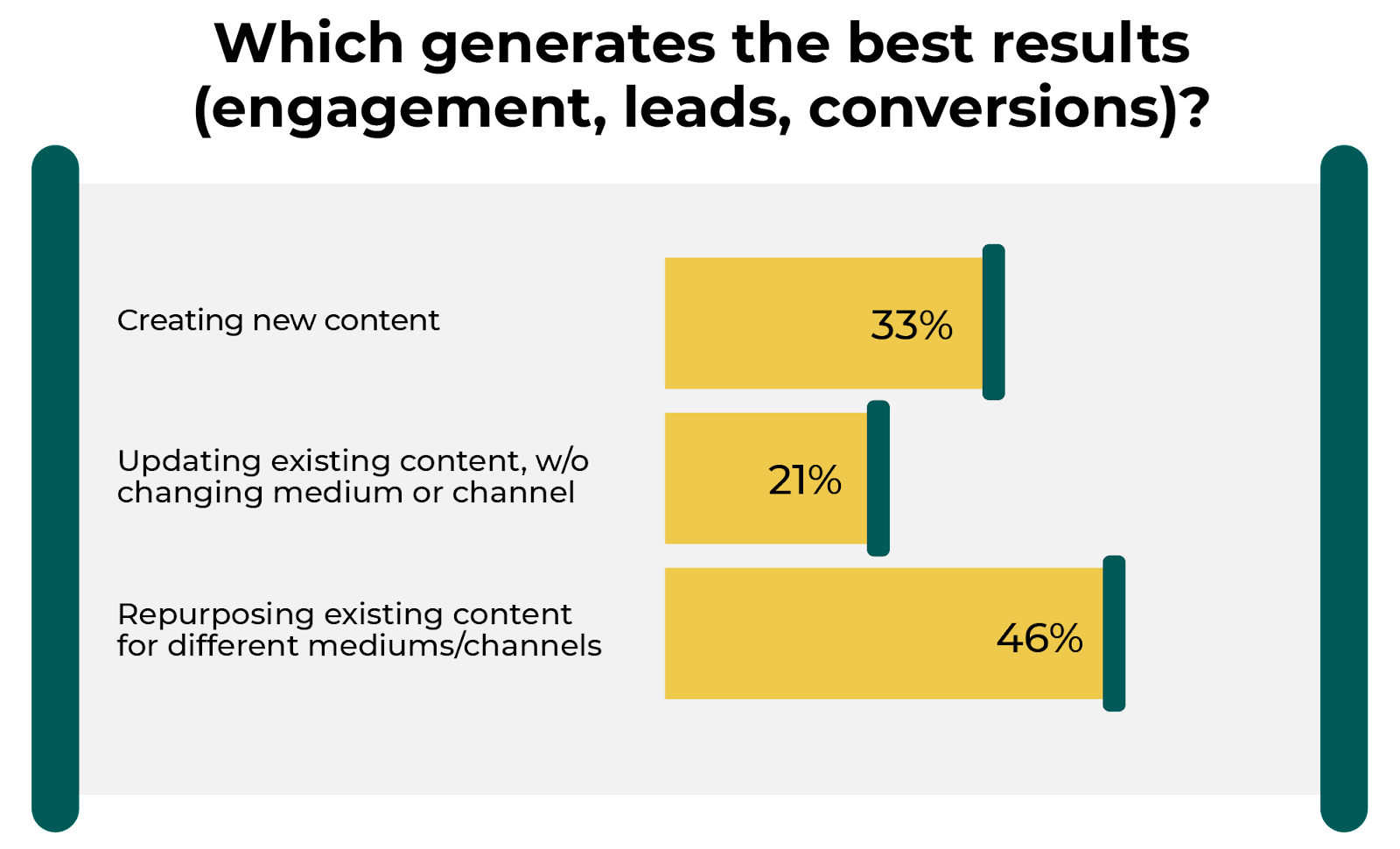
What else do you need to know about content ROI?
- Just 4% of marketers actually measure ROI over a period greater than six months. (LinkedIn)
- Content marketers who blog are 13 times more likely to see a positive ROI than those who don’t. (HubSpot)
- 72% of marketers say they see content marketing ROI in increased customer engagement and increased number of leads. (CMI)
- Marketers struggle to prove the ROI of content marketing, with only 35% saying they can do so quantitatively — 44% only have qualitative or anecdotal evidence, and 21% can’t show the impact at all. (Semrush)
- 72% of successful brands measure content marketing ROI; 65% of unsuccessful brands do not. (CMI)
Content Audit
A content audit is a powerful tool that will help you understand where you are in your content marketing strategy so that you can plan for future success.
Here are some of the details on content audits:
- Among successful content marketing brands, 65% conduct a content audit more than twice a year. (Semrush)
- Of unsuccessful brands, 46% never ran a content audit in the previous year. (Semrush)
- Most brands who conduct a content audit combine it with SEO, with around 70% looking at on-page, off-page, and technical SEO. (Databox)
Content Marketing Budget
So, how much should you be spending on your content marketing efforts? There’s no standard answer, and it will vary based on your brand, industry, resources, etc. But the one thing we do know is this: You absolutely should be investing in your content marketing strategy.
What else should you know about content budgets?
- 70% of marketers are actively investing in their content marketing strategy. (HubSpot)
- Most brands are allocating around 26% of their marketing budget to content. (BloggingWizard)
- A majority of brands expect to increase their content budget in the next 12 months, with 32% projecting a medium increase, 25% planning a small increase, and 15% gearing up for a large increase. (Semrush)
- Marketers are investing more in the following content assets: social media content (41%), high-quality written content (40%), and content promotion and distribution (40%). (Semrush)
SEO Content Statistics
PB&J. Wine and cheese. Blake Lively and Ryan Reynolds. All fabulous pairings, but none quite as amazing as SEO and content. These two were meant to be together, and part of your content strategy should include SEO (or vice versa).
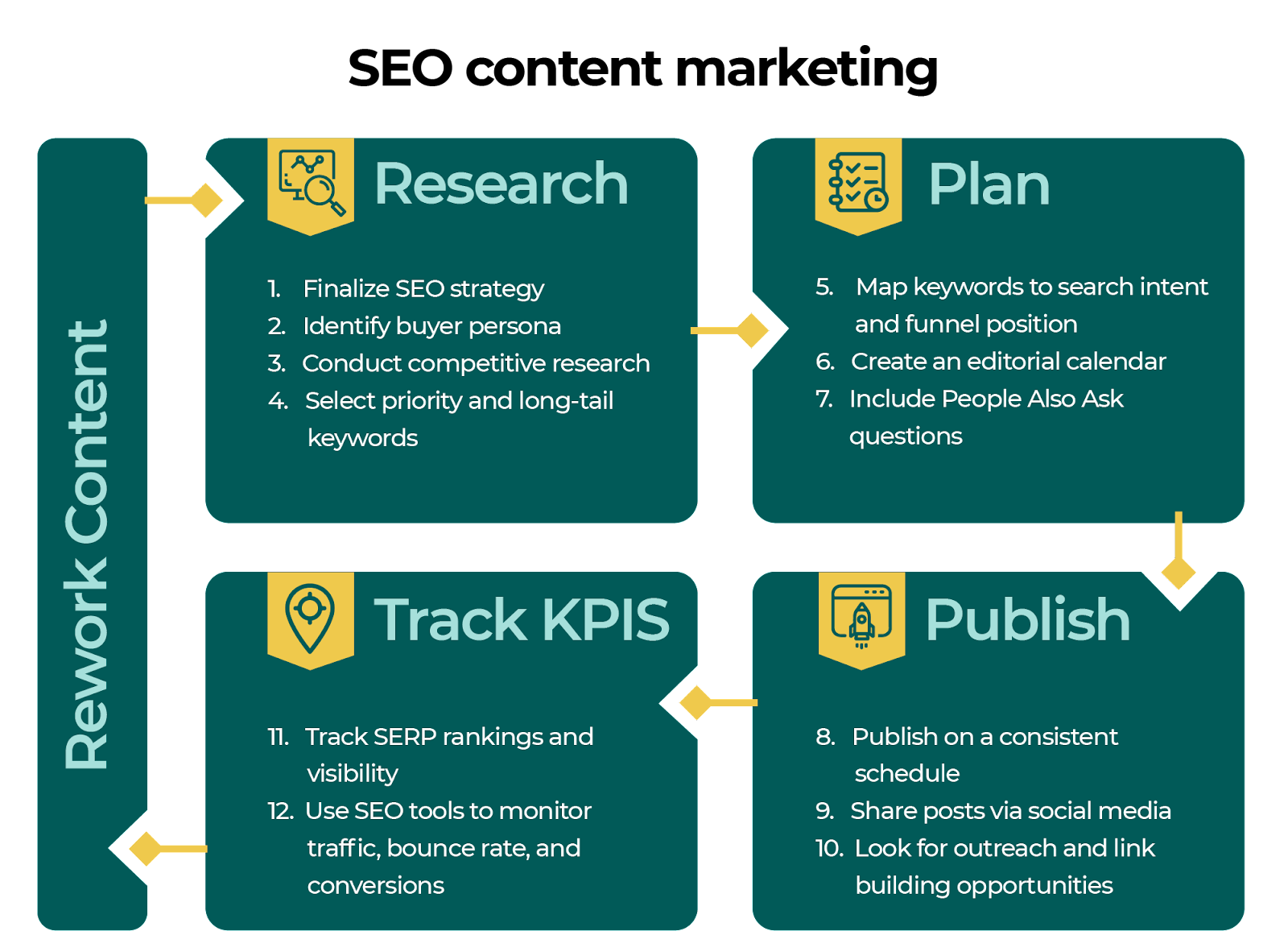
Here’s some of the hottest data on SEO and content:
- 72% of marketers report that content creation is their best-performing SEO tactic. (OptinMonster)
- Conversely, 75% of marketers also said that SEO is their best-performing content tactic. (Semrush)
- Over 90% of web pages get zero organic search traffic on Google. (Ahrefs)
- Over half (53%) of online shoppers search for content on a brand/product before they buy. (Google)
- SEO was cited as the #2 most effective tactic (46% of respondents) for improving content marketing in the last year. (Semrush)
Blogging Statistics
A lot of times, we caution brands to “think outside the blog.” That’s because there are limitless ways to create content beyond the standard blog, and we want them to explore the options. However, there’s a reason the blog is one of the top content marketing methods — it works.
In fact, among SaaS brands, it’s a key indicator of success:
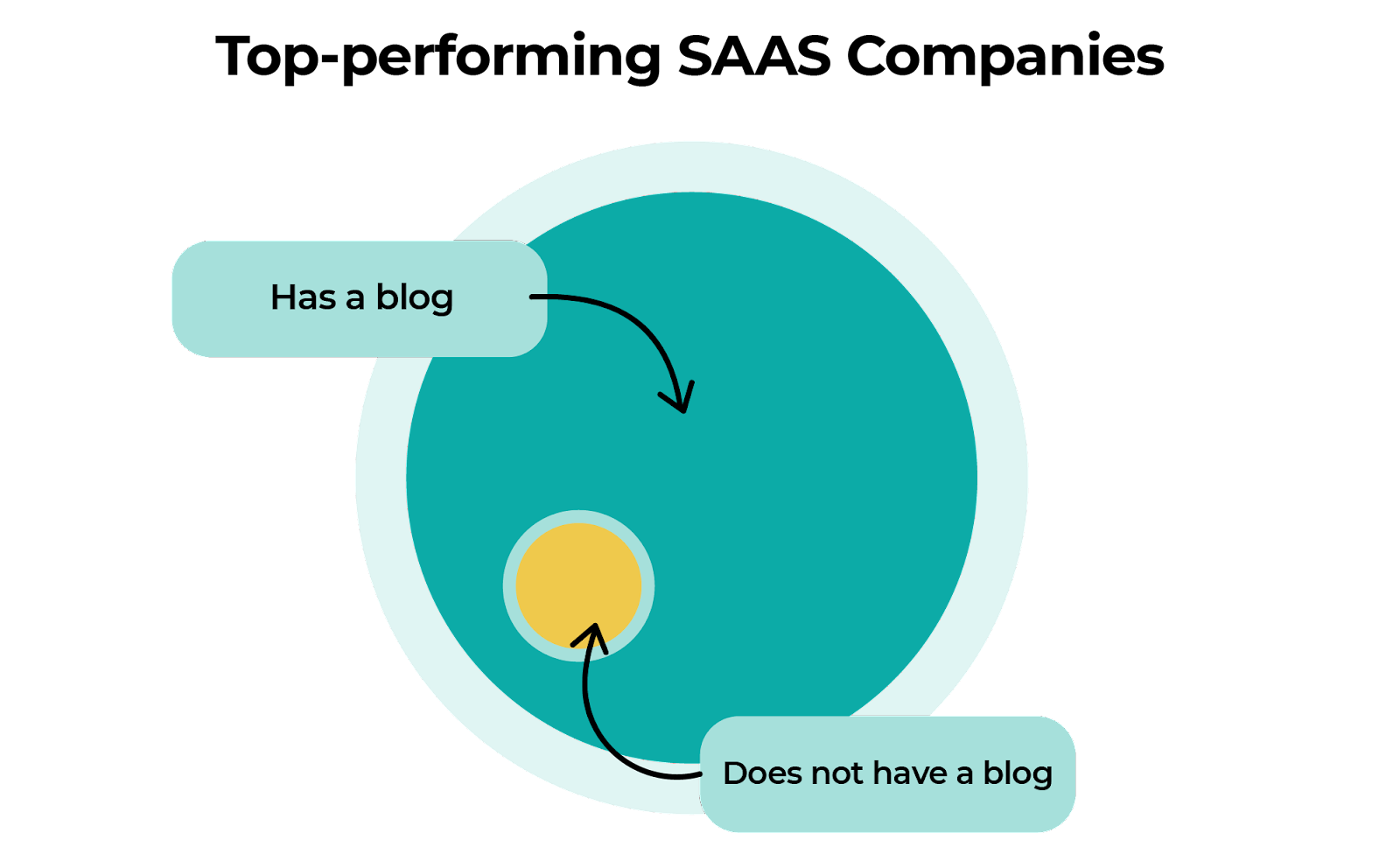
To break it down:
- That’s 98% of top-performing SaaS brands that have a blog. (Business2Community)
- Every month, approximately 409 million people visit over 20 billion blog pages. (WordPress)
- 55% of B2B marketers say blogging works the best for moving prospects through the sales funnel. (Statista)
- Brands that publish 16 blogs or more per month generate 3.5 times more traffic. (Oberlo)
- Time spent on each blog is at an all-time high, at four hours and 10 minutes in 2022. (Orbit Media)
- The most effective content formats within a blog are gated content (35%) and downloadable guides. (35%) (Orbit Media)
- 73% of marketers say updating old blogs is part of their content marketing strategy. (Orbit Media)
Podcast Statistics
Podcasts are becoming more and more popular among content marketers — in part because they’re easier than ever to produce and in part because they’re also growing in popularity among listeners.
What data do you need to know about podcasts?
- 82% of marketers are increasing their podcasting budget or keeping it at the same level in the next year. (HubSpot)
- Overall spending on podcasts will surpass $1.74 billion this year. (Statista)
- Over half (54%) of podcast listeners say they’re more likely to purchase from brands they’ve heard advertise on a podcast. (Edison)
- 38% of B2C marketers claim that the highest content marketing ROI comes from podcasting. (HubSpot)
- Branded content in podcasts grew by 82% between 2020 and 2021. (Chartable)
Image and Infographics Statistics
Nothing outshines visual content, which is something you’ll likely find in your content marketing efforts. Here’s what you need to know about content images and infographics:
- 45% of content marketers use infographics as part of their content marketing strategy. (HubSpot)
- Marketers said that over half (51%) of their content in 2021 contained visual content. (Venngage)
- Original graphics were the most widely used type of visual content (36%) in 2021. (Venngage)
- When asked which type of visual content performed the worst, the biggest group of marketers (41%) said stock photos. (Venngage)
- Only 10% of auditory information is retained, but when a visual is added, 65% is retained. (HubSpot)
- Visual content, like infographics, can boost readership by up to 80%. (Visme)
Video Content Marketing Statistics
Content might be king, but video is the king of content. Video content has experienced a meteoric rise in the last decade as it becomes easier and more cost-effective to create high-quality video content.
Video is especially important to B2B brands, who find that video testimonials are a huge tool for conversion:

Want more details on video content? Here are the stats that matter:
- The main goal of video marketing, according to 36% of marketers, is to increase brand awareness. (HubSpot)
- 37% of brands using video content produce it in-house, compared to just 14% that outsource to an agency. (HubSpot)
- Video content is the fastest-growing form of digital marketing. (Statista)
- The largest group of marketers make videos a few times a week (36%), while 14% do so daily. (Biteable)
- 32% of businesses are using video content to increase sales. (Biteable)
- 74% of marketers believe that video content has a better ROI than standard visual imagery, while 68% say it has a better ROI than Google Ads. (Biteable)
Virtual Event Statistics
During the pandemic, virtual events stepped in to replace in-person events, which was a major shift for B2B brands. How do virtual events stack up in a post-pandemic landscape?
- Virtual events doubled during 2020, as the pandemic shut down most in-person events. (Wild Apricot)
- Research shows that the best time to host a live webinar is 2 p.m. EST/11 a.m. PST to steer clear of conflicts on both coasts. (On24)
- Audience engagement is cited as the biggest challenge of virtual events, but it’s also the biggest predictor of success, according to 49% of marketers. (Markletic)
- 84% of marketers say running virtual events costs them less than hosting an in-person event. (Wild Apricot)
- Over half (52%) of those hosting virtual events saw the same attendance or even greater than they’d expect at an in-person event. (Wild Apricot)
Interactive Content Marketing Statistics
It’s not enough to create a piece of content and toss it out into the void. The best-performing content engages the audience through interactive capabilities.
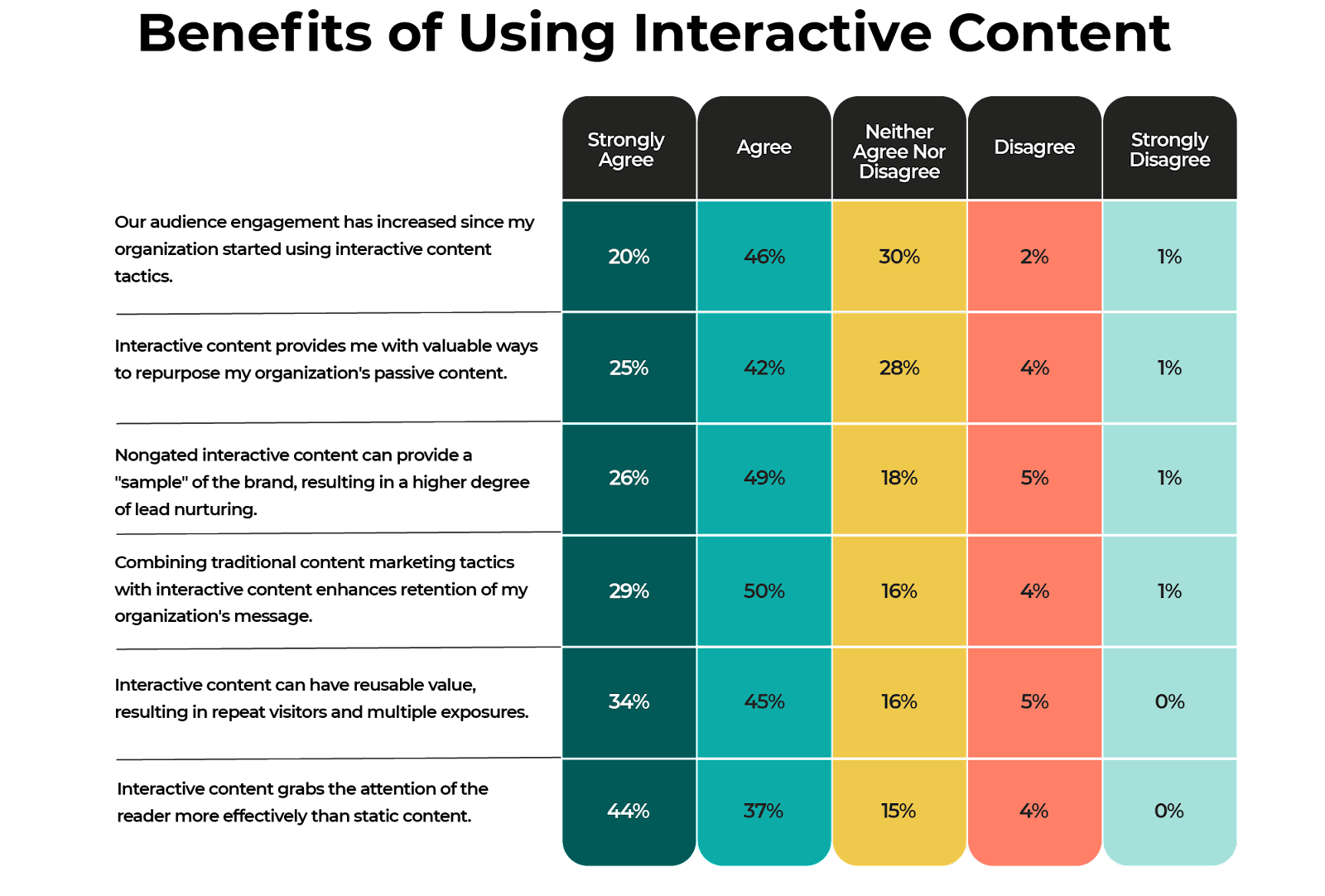
Need more data on interactive content? We’ve got you covered:
- 88% of marketers say they have plans to make anywhere from 10%-30% of their content interactive in the next year. (OptinMonster)
- When it comes to engagement, most marketers say that quizzes (69%) and contests/games (75%) are the most effective. (CMI)
- 79% of marketers say that interactive content helps consumers retain brand messaging better than standard content. (CMI)
Mobile Content Marketing Stats
The times are changing, and that means brands need to change, too. When it comes to mobile usage, chances are good that most of your audience will encounter your brand on their phones or other smart devices. You’ve got to be ready for what’s ahead, so here’s the data you need:
- More searches now happen on phones (59%) compared to computers (39%) and tablets (2%). (Statcounter)
- 83% of the digital audience now accesses social media exclusively on their mobile device. (ComScore)
- Three-quarters of Americans confess to bringing their smartphones into the bathroom with them, proving they’re “always on.” (Convince and Convert)
- 96% of smartphone users searching with Google. (TrueList)
- In-store shoppers will often skip speaking to someone on-site and instead consult their phone to find more information on a product. (eMarketer)
Email Marketing Stats
Email is a tried and true content marketing method that’s been around since the dawn of the internet. You might think email marketing would be tired and old-fashioned at this point, but you’d be wrong. In fact, there’s nothing like a good welcome email to get customers to click on through.
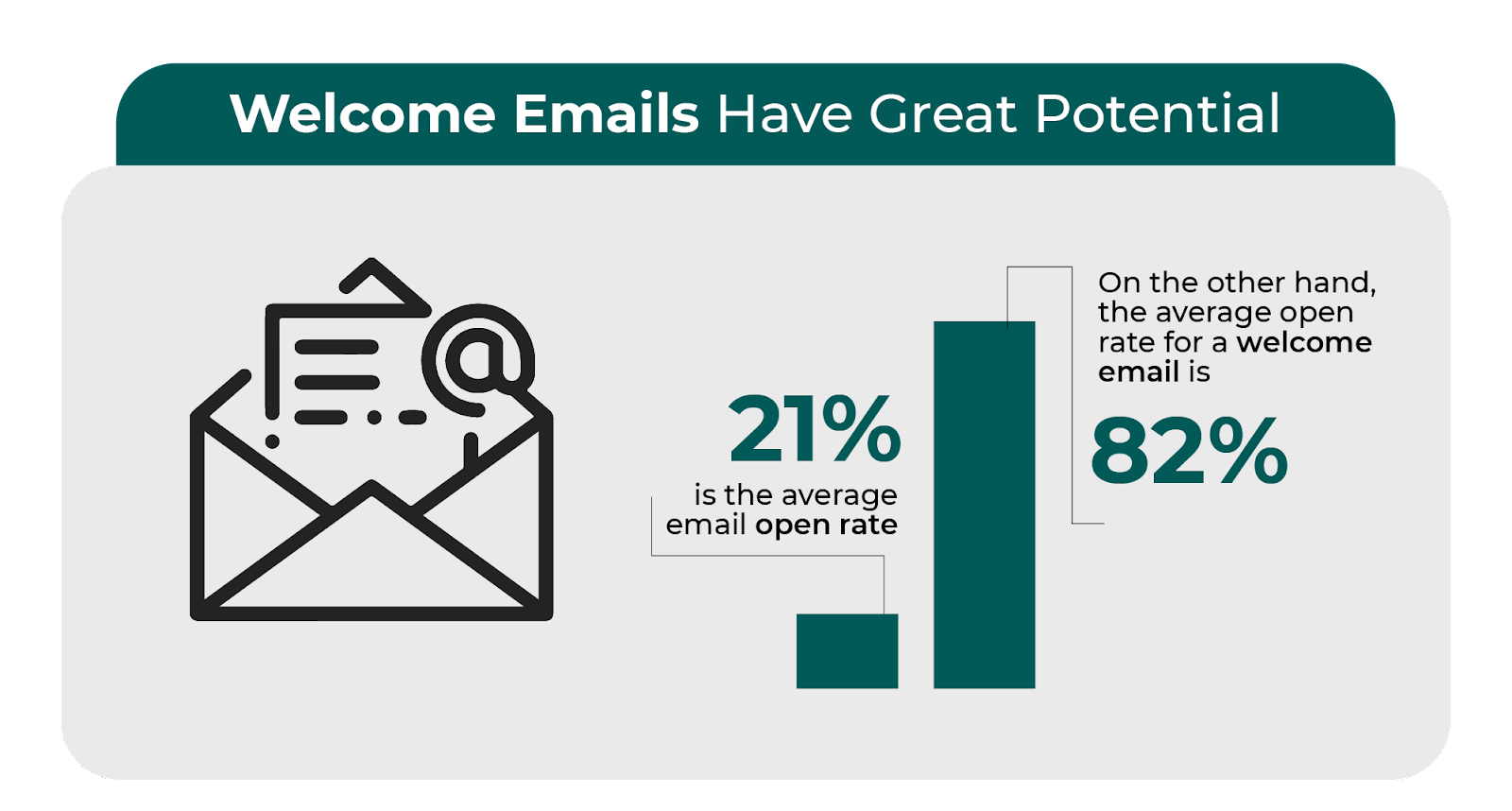
Want more email marketing by the numbers? Here you go:
- When you spend $1 on email marketing, you’re likely to get around $42 in return — a killer ROI. (Oberlo)
- 90% of marketers rely on email marketing for organic content distribution. (Oberlo)
- Using A/B marketing for marketing emails can ramp up conversion rates by 49%. (Campaign Monitor)
- Adding a personalized subject line to your marketing emails can increase open rates by 50%. (Oberlo)
- Including video content in your emails can increase click rates by 300%. (Oberlo)
CRO Statistics
Conversion rate optimization is key to achieving ongoing and sustainable growth. But why is CRO so important to your content marketing?

There’s more than that — here’s the lowdown on why CRO matters to content marketing:
- The average conversion rate for a website is 2.35%, but the very top-performing websites usually see conversion rates around 11%. (WordStream)
- Surprisingly, mobile has the lowest conversion rate at 1.53%, compared to desktop’s 4.14%. (Statista)
- The highest converting industry in B2B is finance and professional services at around 10%. (MarketingSherpa)
- 68% of businesses do not have a CRO strategy in place. (Hotjar)
- Websites with over 40 landing pages convert more, but 62% of B2B brands only have fewer than six pages. (HubSpot)
Social Media Statistics
You might think that social media is its own silo with its own strategy and execution, but in reality, for social media marketing to be effective, you need to make sure it’s fully integrated with your content marketing strategy. Why? Because social media provides your top organic content distribution channels:
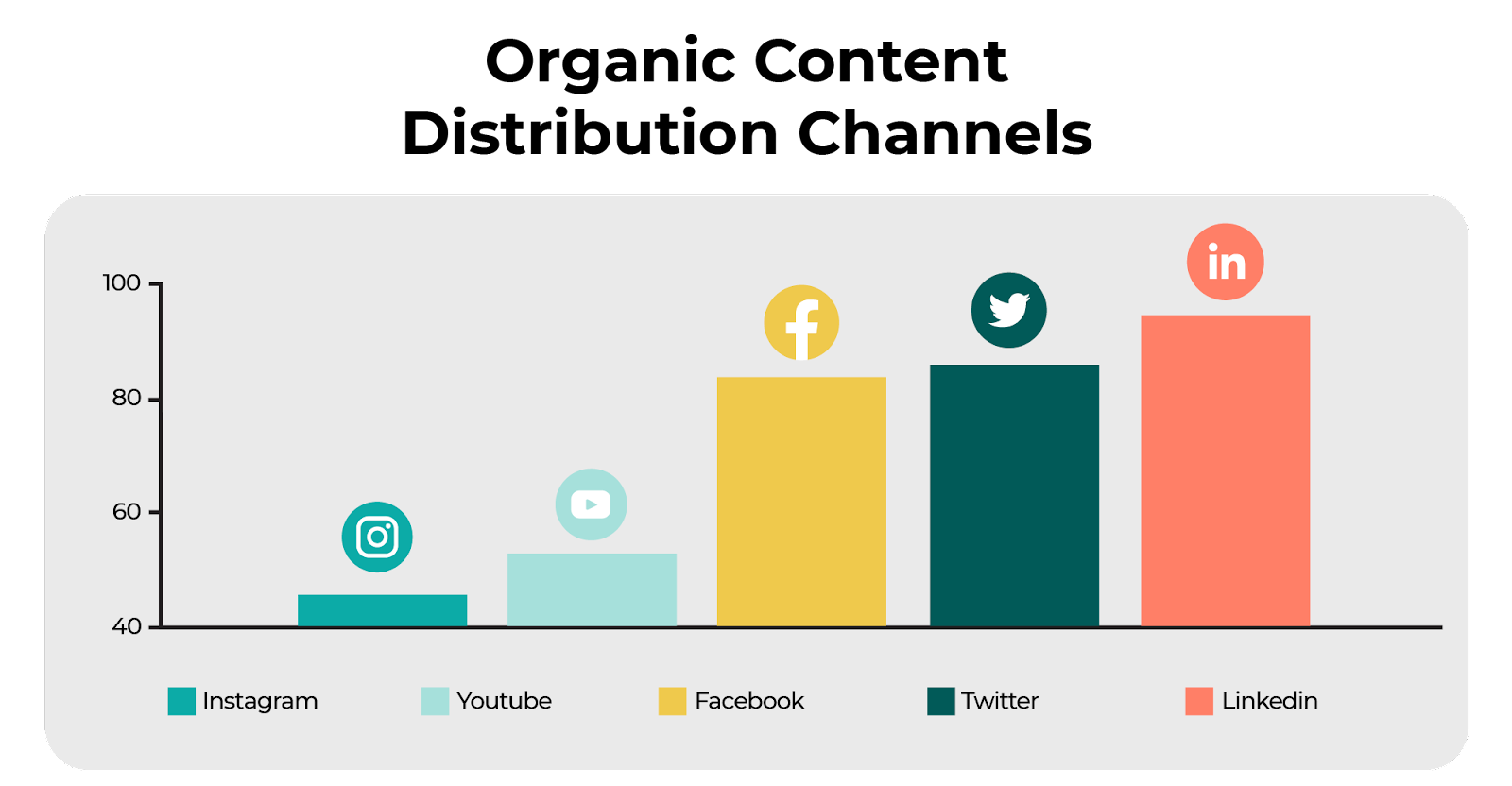
What else do you need to know about social media and content marketing? Here’s the list:
- Over half (54%) of social media users utilize their platforms to research products. (GWI)
- 90% of online shoppers look up brand reviews before visiting that brand’s social media profile. (Bright Local)
- Close to 60% of brands rely on social media Stories and say they have been effective in their content marketing efforts. (Buffer)
- 88% of marketers say that social media is very important or somewhat important to their overall content marketing strategy. (Buffer)
- 73% say that it’s not only important but it’s also an effective part of content marketing. (Buffer)
Content Marketing Trends
What’s ahead for content marketing? We’ve got all the upcoming trends you’ll want to keep an eye on, like this one:
Gated content is going to become even more popular, as it’s incredibly effective for B2B brands who want to earn leads and boost their content.
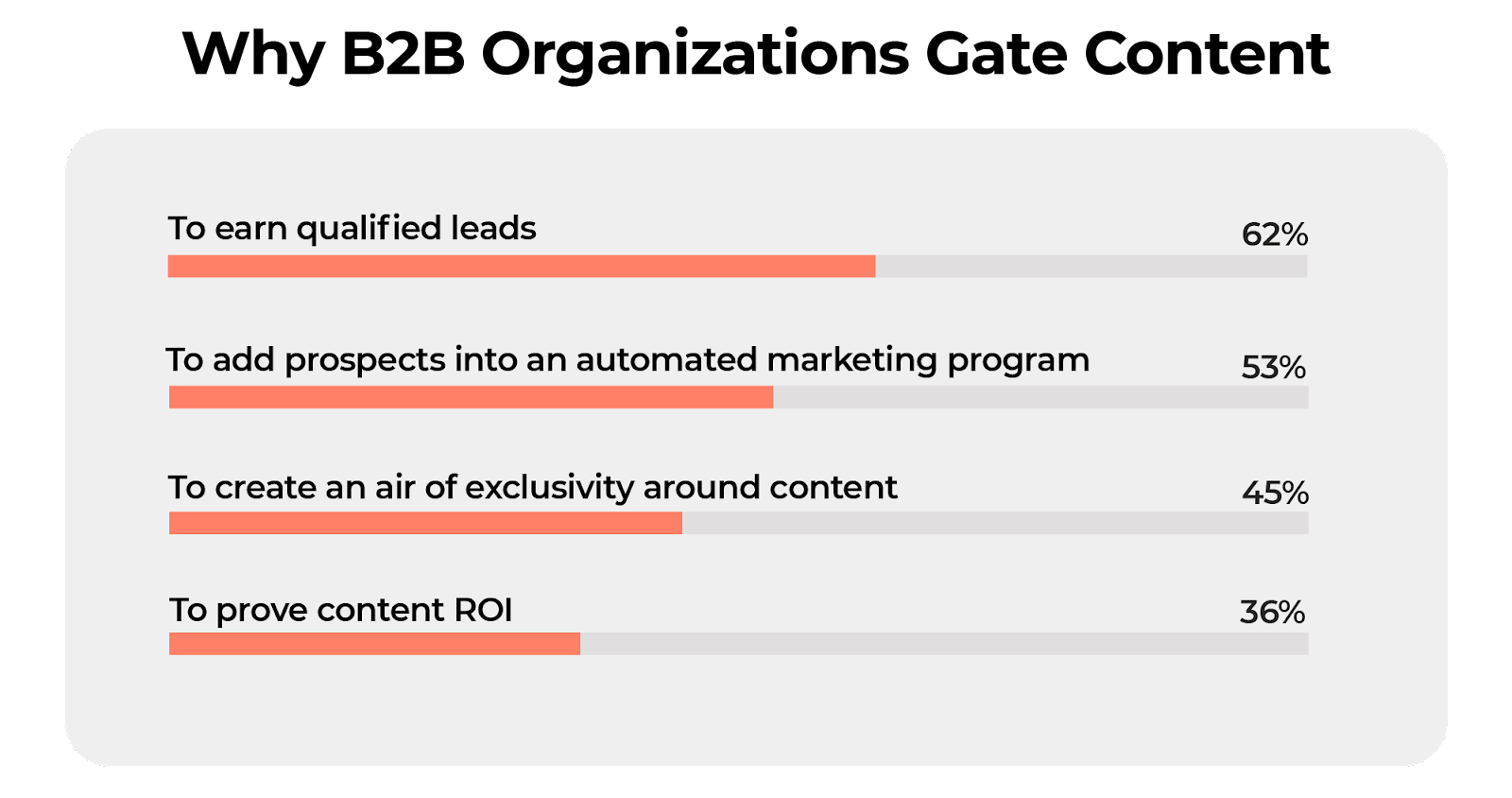
What other trends can you expect to see? We’ve got you covered:
- Globally, 94% of marketers are now budgeting for content marketing. (Semrush)
- User experience (UX) will become even more important to content marketers in light of changes to Google. (Visual Oak)
- 45% of B2B brands have upped their content marketing budget in the last 12 months, and that number will trend upward. (CMI)
- Progressive web apps (PWAs) — websites that behave like apps — will become more popular in 2023. (FinancesOnline)
- Voice search will also continue to grow through 2023 and become a necessary part of content marketing. (FinancesOnline)
- With more people using ad blockers, native advertising, and organic content will become more important in 2023. (FinancesOnline)
Content Marketing Channels Statistics
Wondering where you need to be sharing your content once it’s created? Check the social media statistics above because that’s the bottom line — you must share your content across social media platforms. Aside from that, keep these distribution stats in mind:
- Blog posts are more effective when promoted on social media channels. (StartupBonsai)
- 86% of marketers report that their website traffic grows when they share and prompt video content. (StartupBonsai)
- 81% of marketers use email marketing software to share their content. (Visme)
- Many marketers use paid promotion channels to share their content, including 72% on Facebook, 61% on paid search, 46% on banner/display ads, and 32% on email partnerships. (CMI)
Outsourcing Content Marketing Statistics
Finally, what do you do when it all gets to be too much for your internal team? Outsourcing may be the solution to the content marketing challenges you’re facing. Here are the numbers to back it up:
- Over half of marketers outsource at least one aspect of content marketing, which is usually the creation of content. (Oberlo)
- Therefore, it’s not surprising that 63% of marketers list content creation as their biggest challenge. (CMI)
- 69% of marketers describe trouble finding outside partners with the right expertise as their main concern with outsourcing. (CMI)
Use Content Marketing to Power Long-Term Growth
Outsourcing content marketing certainly comes with challenges, but it also comes with a lot of benefits. When you find a trusted, reliable agency partner, you know you have someone on your side who’s working toward the same goals as your brand.








